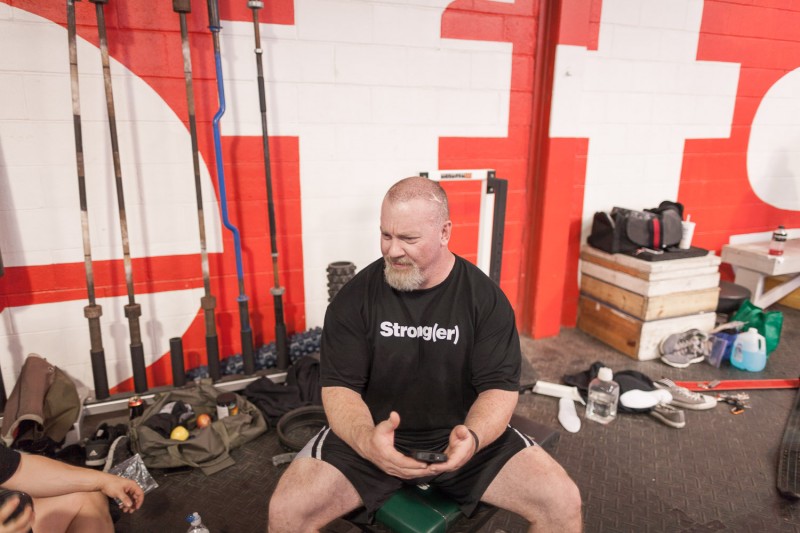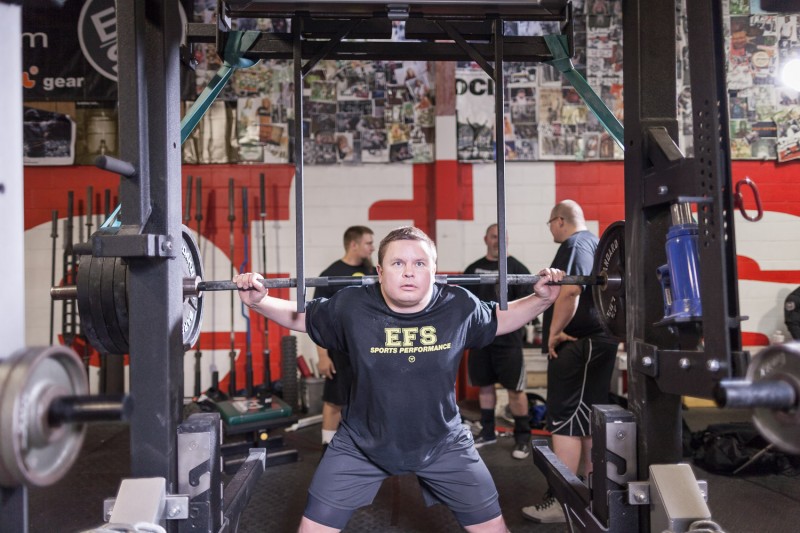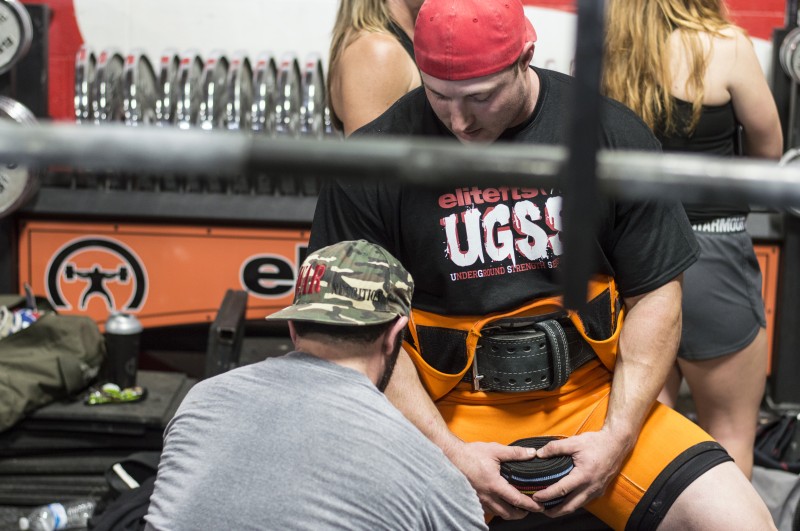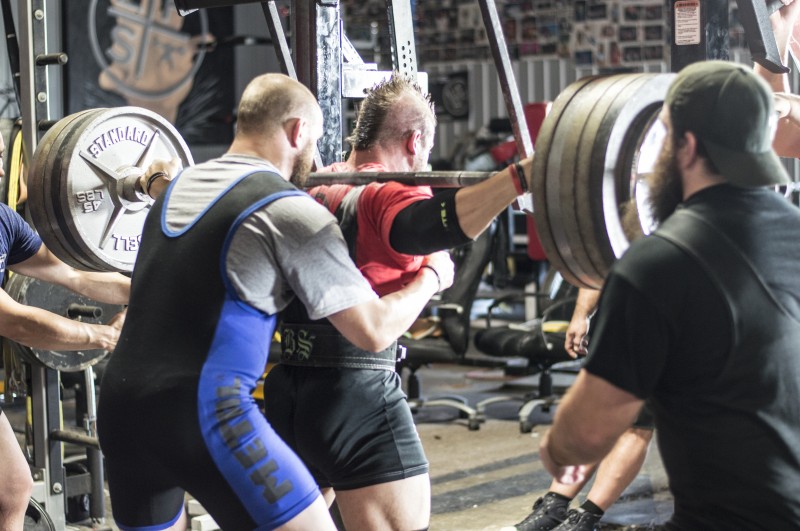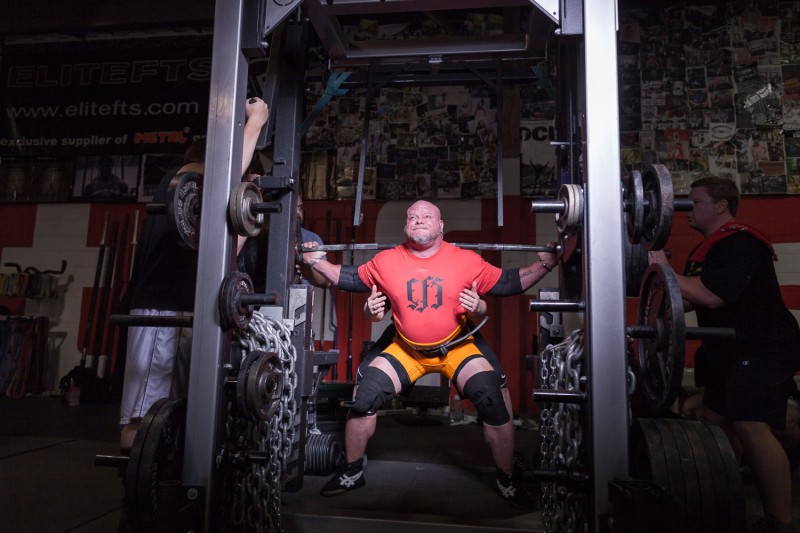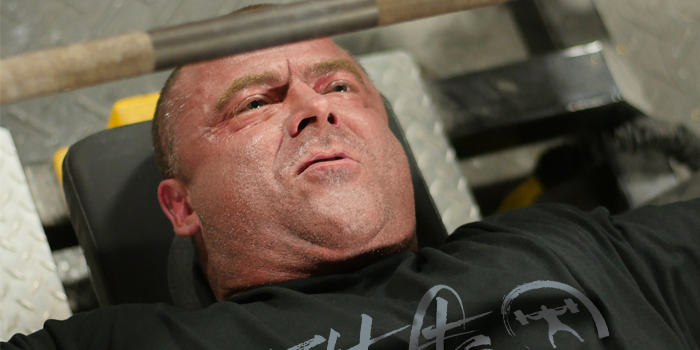
In the blue corner weighing in at 165 soaking wet pounds, sporting a skintight singlet and Fruit of the Loom tighty whities: the overly opinionated and self righteous Roaring Reggie Rawest!
Raw fans go wild.
And his opponent in the red corner, weighing in as a SHW, wearing unlimited plies of polyester, canvas, a secret material covertly manufactured by the Russian KGB, knee wraps, and an unapproved IPF lifting belt: Martin “My Squat Is Bigger Than Your Total" Multi-Ply Jones!
Geared fans go wild.
To be honest, I’m personally getting tired of the “powerlifting racism.” Why can’t people just say, “I’m a powerlifter”? Why does it always seem so necessary to ensure everyone knows you lift raw or raw with wraps or in sleeves or geared? This is always followed with a complete explanation of why your federation is the best and why all the others suck. This is all not to mention the fact that anyone who doesn’t lift in your class or, God forbid, sacrilegiously cheats and wears gear, isn't a real lifter.
Seriously?
I appreciate everyone who lifts and competes regardless of how they decide to lift. How boring would the sport be if you only had one division and one set of rules? Pretty damn boring! Could you imagine going to the drag races and watching the same stock streetcars going down the track running an 18-second quarter mile? You’d have time to smoke two cigarettes and drink a beer before they got to the finish line. Instead, would you like to see some 4000-horsepower nitro methane Top Fuel Funny cars with flames shooting out the exhaust thundering down the strip grasping for control of their spinning, smoking slicks in four seconds at 300-plus miles per hour? I thought so!
RELATED: Why Do You Lift — Defining Hope, Motivation, and Risk
Some lifters started raw and transitioned to geared lifting. Some raw lifters periodically utilize gear for training to save their hips, shoulders, and elbows to extend their lifting careers and to transition into lifting heavier weight. Lifting is lifting. Whether you wear a belt, elbow sleeves, knee wraps, briefs, or multi-ply gear, you are still lifting. Every lifter has a different background, a different history, and a different story of what brought them to powerlifting and the decision to lift raw or in gear.
I am a geared multi-ply lifter. Why do I like to lift in gear? I love how extreme and challenging it is to lift in gear, for a lot of reasons: The mental challenge of trying to stand up with so much weight on your back that you wonder sometimes if you’re going to make this lift or die. When you descend on the squat and your vision goes blurry, you feel like you’re on the verge of passing out, and it literally feels like your head is going to blow apart like a nuclear bomb! The never-ending challenge of trying to improve your technique so the gear doesn’t control you.
Geared lifting is an extreme sport. I love the intensity and challenge and I can’t see myself switching over to lifting raw anytime soon. But, never say never.
I can remember exactly how I became involved in the sport. I was at the Arnold Sports Festival in Columbus Ohio in March 2012 and I somehow ended up at the main floor when squats started at the XPC Powerlifting meet at the old Veteran's Auditorium. I remember seeing Brian Carroll, Al Mehan, Chad Walker and a bunch of other behemoth lifters. It seemed like every lifter was squatting 1000 pounds and I was like a frickin' pre-teen schoolgirl at the front row of a Justin Bieber concert.
I was completely blown away! I wandered into the warm-up room and was stunned at the size of these lifters. Everyone had no neck, mountainous traps, lats like sides of beef, monstrous quads; these were the strongest giants I had ever seen, and I was hooked! I didn’t know anything at all about powerlifting so I started to snoop around on the Internet, found elitefts and Westside barbell and started reading. If anyone knows me at all, you know I never do anything half-assed. I didn’t even really know the differences between raw and geared lifting. All I knew was that if I was going to try powerlifting, I was going to jump in with both feet and start in gear. WTF? I actually drove to London, Ohio to elitefts and picked up a set of Ace briefs, an Ace Pro Squatter and a Metal Ace bench shirt.
Now what?
My first move was to contact Bruce McIntyre, who was the president of the Canadian Powerlifting Federation. I sent Bruce an email and asked if he knew anyone in the Toronto area that I could train with and learn how to powerlift. Bruce put me in touch with Clint Harwood, who is Canada’s biggest bencher who held an 859-pound, drug-free AWPC World Record.
Clint had a small single car garage gym in Toronto known as the infamous “Anvil” that had a monolift, a competition bench, and a deadlift platform. I didn’t know what to expect. My first trip to the Anvil I met about ten lifters, all jammed into a small space who were all incredibly friendly, helpful and encouraging. I owe everyone at The Anvil a ton of gratitude for helping me get started, helping me learn how to lift, and pointing me in the right direction in this sport. One thing is certain for geared lifters: you can’t train properly or safely without having a team of people willing to help you train. Period. You have to have a reliable group of training partners to excel and progress.
Each lifter is an individual who has had a different history and journey that has led them to lift in a specific discipline. Why should anyone belittle or berate their decision? I’ve had the opportunity to speak to some of my elitefts teammates about their thoughts, opinions, and decisions about why they decided to lift raw or in gear. Everyone has a different story.
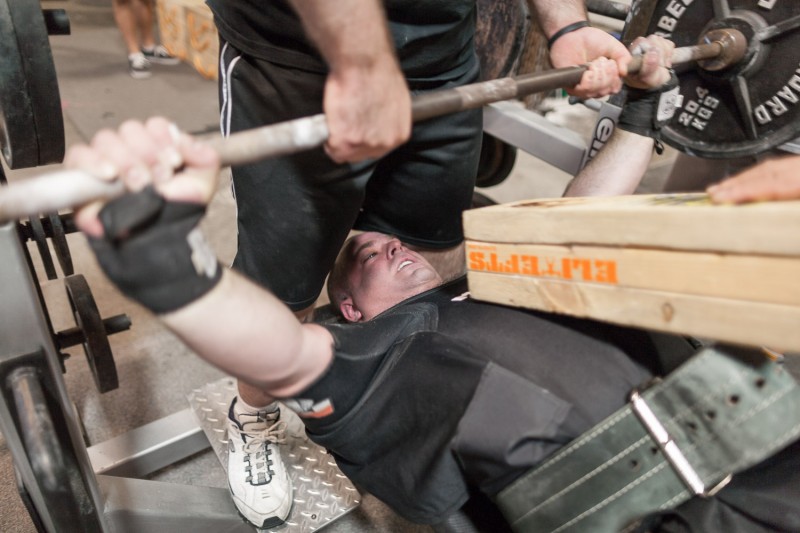
“I use a little gear to stay healthy and pro metal briefs for hip health. Other than that, I don't because I have crappy shoulders." —Thomas Deebel
“I started raw because that's all I understood at the time. I didn’t have any access to training partners or a monolift so training raw was really my only option. I'm continuing to lift raw due to the competition and enjoyment of it. It still makes training easier as well.
I have done a bench-only multi-ply meet, and loved it. I'll certainly be hitting the platform in gear, and honestly can't wait. I'll always be a raw zealot, but I also want to be well-rounded and remain healthy for the long run.” —Brandon Smitley
“Like most lifters at the time (now 20 years ago), I did my first couple of meets raw, then quickly transitioned to the single-ply gear of the day (crap by today's standards). After a couple of years of this, I moved on to multi-ply, because that's what my training partners were doing.
RELATED: Building the Raw Bench Press
Raw lifting as a movement really wasn't a thing back then. Nobody had any interest in taking away support. We were all about the next big suit or shirt that would put 100 pounds on our total while taking 10 years off of our lives.
While you occasionally saw someone at a meet lifting raw, it was a rarity, and they wouldn't even have their own class. They just lifted in the same class as the geared guys and lost. Pretty admirable compared to today's standard of a class and a trophy for everyone.
Today I lift in gear because it's what I've always done, and what I'm comfortable doing. I have a ton of respect for the strong raw guys out there, but I have no interest in going this way myself. I suppose if gear ever fully "dies" I will lift raw when meets stop offering geared classes, but for now, I like the increased challenge of lifting in gear, as well as the bigger weights it allows me to handle.
I suppose nostalgia plays into it a lot. When I started this sport, it was a bunch of big bloated crazy motherfuckers risking their lives in shoddily patched and duct-taped sail canvas.
I'm holding out hope that it will someday go back to this when the hipsters move on to something else”. —David Kirschen
“I viewed gear as a natural progression. I started raw, then added layers over time. I don't ever plan to go back to raw. I like the protection of gear now that I am well into my 40s. More importantly, I enjoy the challenge of getting gear right. Raw lifting is boring by comparison. Not to mention the ego hit when I'd have to explain to the tens of people who follow me on Facebook why my total has gone down by 600 pounds.” —Steve Diel
“I compete in powerlifting to lift the most weight possible. Competing in equipped divisions is way more fun for me as well as much more intense.” —Mario D’Amico
“I started raw because lifting was a part of training for football. Then it turned into a sport for me. The group that got me into training was ex-gear guys and just trained raw because it was easier for them because of their age and work schedules. I played around with briefs and a shirt every now and then, after training at Westside for a couple years on the weekends.
During that time I was still learning what the hell powerlifting was — federations, single-ply vs. multi-ply, knee wraps vs. knee sleeves.
At some point I realized that the strongest lifters in the world are competing raw. To quote the great Ric Flair, if you want to be the man you have to beat the man. So I stuck with it because it's more popular and I guess more respected (perception is reality).
With all that being said, I just did a single-ply meet out of necessity and curiosity. It gave me enough support that I could train through some hamstring discomfort and rehab. Plus it gave me something to take my mind off of what felt like the grind of training raw.
So, raw4life...until I do my next single-ply meet in a year or two. And I'll probably do multi-ply and go after Chuck V's 242 squat. —Casey Williams
“I competed for the first couple years in raw meets, and then transitioned to multi-ply gear for the past three and a half years. Part of the reason is that the training crews I lifted with all lifted in gear, and then I liked the technical challenge of equipped lifting and the ability to move weights beyond your unequipped potential. I also like the difference that being a good technical and strategic lifter can make in meets. Often times it isn't the strongest person who wins a meet but is the one who competes the smartest (some people would view this as a negative, but I appreciate this extra focus on getting good at the skill of competing).
This past year after the Arnold I started transitioning back to competing raw again, mainly because with my hip injuries I'm unable to use the technique that gets the most out of gear and raw, narrow-stance squatting is the only way I can squat without extreme pain now. I also was admittedly getting a little tired of all the variables that equipped lifting can involve and just wanted to focus on getting stronger and not spend so much time worrying about how the equipment. Also, with the shift in popularity of raw lifting, I noticed the majority of the strongest lifters in the country (at least via the rankings lists) seemed to be competing raw (outside of the top few percent of equipped guys) and I wanted to compete in those divisions.
I likely will compete in gear again (at least a push-pull), but for right now my focus is on getting stronger and qualify for a bigger raw meet (probably either XPC or something similar. IPF if I can keep squatting low enough).
I'll always tell people I love and appreciate both styles of lifting. They're very different, and there are pros and cons to each. I'm glad we have choices and people have a blast doing both”. —Joe Schillero
“Similar to other responses, when I was introduced to powerlifting none of my group was training in gear yet. By the time a few of them decided to make the switch, I already had personal goals laid out to accomplish in the raw classes.” —Christian Anto
“I trained and competed raw for about five years before switching to gear. Had two injuries in back-to-back meets that took me out for a while. I switched to bodybuilding for a while and have only recently transitioned back to powerlifting. Gear training is like driving a top fuel dragster: you go to the absolute max but the room for error is very narrow and the chance for disaster is much greater. This caters to my more extreme side and tickles that desire to push the limits. It does, however, take forever to get a training session in and you need the right people and the right equipment. The learning curve is steeper and it can be a frustrating process. Raw lifting is a bit more simple and easier to find people to train with. It's not as extreme but it also seems more realistic for long-term training. I enjoy them both for what they are.” —David Allen
MORE: Is There Really A Difference Between Raw and Geared Lifting?
“I started off geared, mostly because I just wanted to lift heavier and heavier. I enjoyed being able to handle heavier weights and the challenge of learning geared lifting. I recently did a raw meet, mostly again for the challenge of learning something new and doing something different. If I could do well, geared lifting, could I make it to the top raw as well? Just another goal to chase.” —Julia Ladewski
"When I started powerlifting there was no geared division. It was just powerlifting and everyone wore whatever gear was available. I wanted to be one of the baddest motherfuckers in the world so I learned the gear.
Well into my career I had noticed some people doing this raw thing. Now, I knew there were guys out there who literally could not bench 365 without a shirt, but could bench 700 in it (yes, I witnessed it in the warm-up room). Meanwhile I would warm-up to 500. I would get so confused when people would ask, "Are you taking that without your shirt?" Or I'd get, "Aren't you going to at least use some boards with that?" It was like I was performing some magic trick.
With the raw thing out there, I figured I could be one of the baddest motherfuckers out there as well. The shame of it is that I could have probably been much better at one or the other if I stuck solely to it, but I really enjoyed both.
I think doing both helped lengthen my career, actually. I hear a lot of guys putting on some gear to help them out now later in their lifting tenure. I find the opposite. My body can no longer handle the gear. It can't take the overload anymore”. —Vincent Dizenzo
“I started out as a raw bench-only guy for my first 10 years. I had never seen or heard of geared lifting until me and one of buddies went to a meet and a couple of guys were benching in the mid 600's wearing these denim shirts. My training partner and I thought it was the coolest thing ever and had to get one. We did not know anything about how to train in them or knew of anyone to get advice from, we just knew that was we wanted to do!
It just so happened at my next meet a couple months later Travis Mash came up to me asked me who I was, where I trained, and if I did geared lifting too. I’m not sure if I actually heard a word he said at the time because Travis Mash was actually talking to me! Long story short, Travis introduced me to gear and I was hooked and I started training with him and his crew for several years. Six months later I did my first bench-only geared meet and benched 650 pounds right out of the gate weighing 250 pounds. In my third meet in a bench shirt, I benched 700 pounds under Travis’s coaching. From then on I was hooked.
Eight years back around age 34 I decided to dabble in raw, full power just for something else to challenge me. I totaled elite in my first raw, full power meet then proceeded to do two more raw, full power meets that same year just to see what I could do. My best raw lifts during those three raw, full power meets were a 750 squat, 530 bench and a 615 pull. I have not done any raw meets since.
I went back to being a gear whore in my shirt benching over 800 a few times. I decided next to try and throw my hat in on geared, full power and in my first geared, full power meet I hit my elite total. I did a second meet soon after. Five years later I finally did my third geared full, power meet, which I just did this past March after recovering from a couple of surgeries. My best geared lifts in full power are an 850 squat, 775 bench, and 600 deadlift. I have done three raw, full power meets and three geared, full power meets and hit three different elite totals. I have done at least 50 raw and geared, bench only meets. I have enjoyed doing both raw and geared through my 20+ years of competing. Both have their positives and negatives. I just love to lift and compete, it does not matter in which one. Both are fun but with gear you need help, spotters, and coaching to learn the stuff. I respect any type of lifting and all lifters that compete on the platform regardless of their lifting preferences”. —Joey Smith
"My first two meets were raw back in 1997 and 2000. I saw guys in gear at those meets and was intrigued by it, so I ordered some single-ply stuff to try out and stuck with it for a few years until I got bored with it and slowly began adding a ply here and then a ply there, which led to where I am now: a gear whore. I love lifting in gear since it spares my joints some and allows me to train much heavier and longer than I could without it. It's fun, technical, and training in it always presents a challenge to try and perfect the movement and get the most out of what I'm wearing." —Jo Jordan
“Powerlifting for me has always represented a progression with the end goal being lifting as much weight as humanly possible. To me, this meant you start out as a powerlifter raw and build a very strong base. Once I hit some goals and my lifts started to get a little stagnant, it was time to try single-ply. Lifting multi-ply was always the end game for me. I knew I wanted to be one of the strongest lifters around and to do that it meant working up the ranks of gear, ending with multi-ply. The different divisions of raw, single-ply, and multi-ply were never really "different" to me; it was all just powerlifting.
The last 5-10 years has really highlighted a difference between the sub groups, but to me it's still just powerlifting. You started raw and ended in multi-ply. In the past few years I have become physically and mentally stagnant, so I decided to venture back into raw and single-ply training and competing. This has enabled me to leap frog my multi-ply limits as a result. You clear your mind and give yourself an opportunity to strengthen weaknesses. One big difference between raw and multi-ply is the level of and different types of "toughness". It is my opinion that to be a great raw lifter you need to be tougher physically. To be a great multi-ply lifter, you must be very tough mentally. Of course, there are always the 5% at the top that are both, but that is why they are at the top." —Marshall Johnson
“I have only been powerlifting competitively for about two and a half years. I dabbled with the big three lifts with Ken while he prepped for his first meet. My first real life-changing experience was watching Ken and all the lifters at the Detroit Relentless meet in November 2013. I always thought I wasn’t strong enough to be competitive. At Relentless I saw that it was not only about lifting weights. Powerlifting was more than that to some people; it was about helping terminally ill children and their families. I cannot even begin to express what being part of this event meant to Ken and me. I watched in awe at all the strong men and women — they called themselves “The Iron Sisters.” I left that day and told myself I too wanted to become as strong as I could and be an “Iron Sister.”
I signed up for my first raw powerlifting meet and have not looked back. Every single meet I become stronger, better and keep growing my raw total. Earlier this year I put on a pair of single-ply briefs for fun to see what it would feel like. Holy hell, I had bruises on my legs and hips for a week.
That was post shoulder surgery, so I was a bit hesitant to even put too much weight on my body at that time. I am 54 years old and about to compete at my second WPC World Championship in November 2016. I have lifted at the Arnold’s in 2015 and hope to do so next March. I am in search of that 1,000-pound raw total for World’s. Perhaps once I have reached that goal then I may enter the darkside and dabble with some gear. I have had a few injuries in my life so I want to lift as long and as safe as possible. Whatever it takes to keep me under the bar. Being part of Team elitefts, having a great home gym, a husband with the same passion, and our Outlaw Crew to train with have been the reasons for my success." —Sheri Whetham
Different lifters. Different journeys. Different opinions.
RESPECT: Pass it on!









